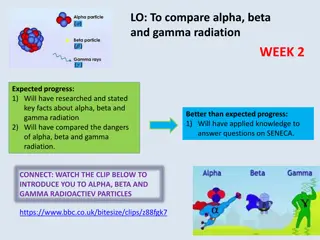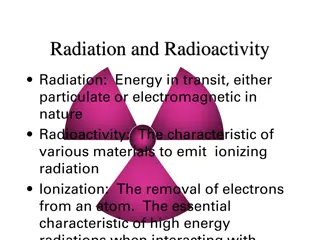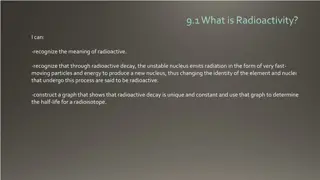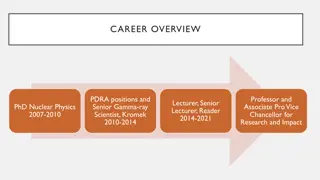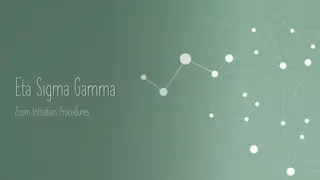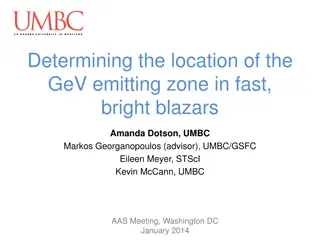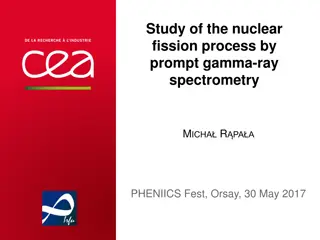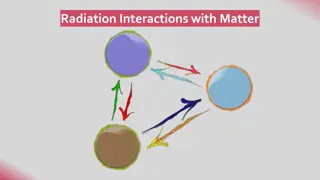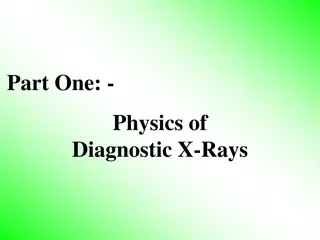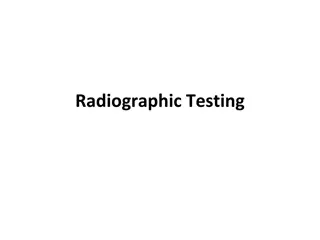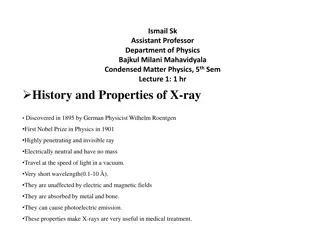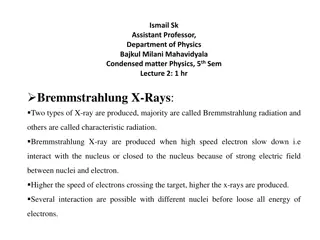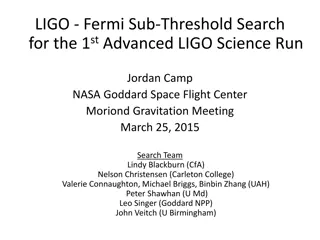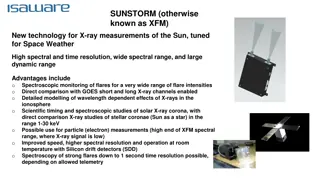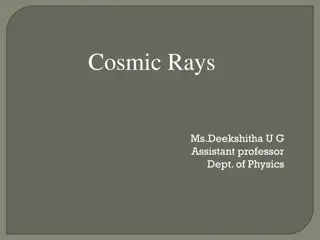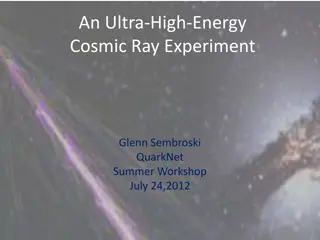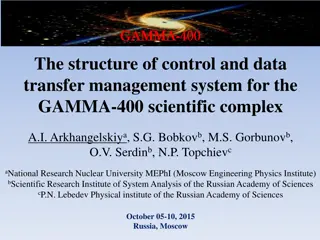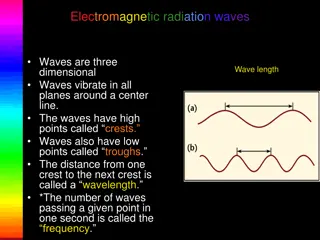Understanding Radioactive Decay and Nuclear Radiation
Radioactive decay is the process in which unstable atomic nuclei emit charged particles and energy, transforming into different elements. This process involves the emission of alpha particles, beta particles, and gamma rays. Alpha particles consist of two protons and two neutrons, beta particles are
4 views • 31 slides
Ensuring Safety and Quality- Gamma Radiation Sterilization for Diverse Applications
Ever wonder how bandages and medical tools stay germ-free? Gamma radiation sterilization eliminates bacteria & viruses using powerful rays! Learn how this safe and effective process ensures top quality in various industries. Visit Symec Engineers to explore its diverse applications
3 views • 3 slides
Understanding Radioactivity and its Particles in Radiochemistry
Radioactivity involves the spontaneous decay of unstable atomic nuclei, releasing radiation in the form of alpha particles, beta particles, and gamma rays. Alpha particles are heavy and have low penetration, beta particles are light and faster, while gamma rays are high-energy waves with great penet
1 views • 20 slides
Understanding X-Ray Radiation: A Comprehensive Overview
X-ray radiation, discovered by Wilhelm Conrad Roentgen in 1895, is a high-energy electromagnetic radiation with a frequency range of 3.10^16Hz to 3.10^19Hz and a corresponding wavelength range from 0.01nm to 10nm. This form of radiation has applications in various fields, and its properties make it
0 views • 15 slides
Understanding Alpha, Beta, and Gamma Radiation: a Comparative Analysis
Explore the key differences between alpha, beta, and gamma radiation, their structures, penetration powers, absorption materials, ionizing abilities, and dangers. Learn about isotopes, radioactive decay, and the unique characteristics of each type of radiation. Dive into creating fact sheets and und
2 views • 7 slides
Understanding Radiation and Radioactivity in Science
Radiation is energy in transit, while radioactivity is the emission of ionizing radiation by materials. This process involves ionization, which removes electrons from atoms, leading to various nuclear decay processes such as alpha decay, beta decay, gamma-ray emission, positron decay, electron captu
0 views • 80 slides
Understanding Radioactivity and Nuclear Radiation
Radioactivity is the process in which unstable nuclei emit radiation, such as alpha, beta, or gamma particles, to become stable. This emission can change the element's identity and is crucial in fields like nuclear power and understanding Earth's core heat source. Different radioactive isotopes like
0 views • 12 slides
Introduction to Gamma Function and Equivalent Integral Forms
The Gamma function is a versatile mathematical function that generalizes the factorial function to non-integer and complex values. It has various integral definitions such as the Euler-integral form. The proof of the factorial property of the Gamma function is demonstrated through analytical continu
1 views • 20 slides
Understanding Radiation Pollution and Its Sources
Radiation pollution is a serious environmental concern caused by both ionizing and non-ionizing radiation. Ionizing radiation, such as alpha and beta particles and gamma rays, can lead to cellular damage, while non-ionizing radiation, like solar radiation, can also impact living organisms. Sources o
0 views • 15 slides
Understanding Soft Gamma-Ray Emissions from Pulsar Polar Caps
Soft gamma-ray emissions from the polar cap cascade region are a subject of interest in astrophysics, with studies focusing on the fundamental physical processes of pulsars and potential origins of non-thermal X-ray emissions. Researchers explore the emission processes, polar cap accelerators, casca
0 views • 16 slides
Accomplished Career in Nuclear Physics and Gamma-ray Spectroscopy
Experienced professional with a diverse background in nuclear physics and gamma-ray spectroscopy. Successfully held positions including Senior Gamma-ray Scientist, Professor, Associate Pro Vice Chancellor, and more. Achieved significant milestones such as securing research funding, supervising PhD s
1 views • 4 slides
Eta Sigma Gamma Zoom Initiation Guidelines
Hosting a remote initiation ceremony for Eta Sigma Gamma using Zoom is crucial during the pandemic. Follow the outlined steps for a seamless ceremony preparation and execution, ensuring the significance of the event is maintained. Key elements such as rough schedule, necessary materials, and new ini
1 views • 8 slides
Understanding Gamma Knife Stereotactic Radiosurgery
The Gamma Knife Stereotactic Radiosurgery is a precise and effective treatment method where highly focused radiation beams are used to target tumors and abnormalities in the brain. It does not remove the tumor directly but affects DNA, cell growth, and blood vessels. The procedure involves three mai
0 views • 51 slides
Exploring Cosmic Ray Sources Using Gamma-Ray Emission Data
This study focuses on investigating ultrahigh energy cosmic ray (UHECR) sources by analyzing extragalactic diffuse gamma-ray emission data. Techniques such as examining UHECR mass composition and arrival directions, as well as studying interactions with cosmic microwave and extragalactic background
0 views • 16 slides
Understanding the Location of Gamma-Ray Emission Zones in Blazars
This research explores the determination of the GeV emitting zone in fast, bright blazars through studies conducted during the AAS Meeting in January 2014. The focus is on locating the gamma-ray emission zone within blazars and investigating the critical differences between various energy scales lik
0 views • 23 slides
Overview of Observational Techniques and Student Talks in Astronomy
This content covers observational techniques, student talks, and dates related to various astronomical topics such as gamma-ray astronomy, basics of gamma-ray interaction, scintillators and solid-state detectors, Compton telescopes, and pair telescopes. It provides insights into the main processes i
0 views • 23 slides
Initiation Ceremony for New Eta Sigma Gamma Chapter Members
Witness the initiation ceremony into the Eta Sigma Gamma collegiate chapter, where new candidates are introduced and inducted with solemn rituals and historical significance. From the candle-lit entrance to the recitation of pledges, experience the traditions and values upheld by this esteemed profe
0 views • 27 slides
Study of Nuclear Fission Process Through Gamma-Ray Spectrometry
Delve into the nuclear fission process through prompt gamma-ray spectrometry, exploring motivations, experimental data, and preliminary results. Understand the gamma heating process in nuclear reactors and its significance in reactor safety. Contextualize the study within Generation III+ and IV reac
0 views • 86 slides
Insights from PADME ECal Meeting: Rejection Studies and BG Analysis
Explore the discussions and findings from the PADME ECal meeting on topics such as gamma rejection studies, toy MC studies of gamma background, ECAL geometrical definitions, BG studies, and detector acceptance. Key points include the proposal for a lead glass-based SAC and considerations on ineffici
0 views • 27 slides
Photoproduction of Pionic Atoms at the Gamma Factory: Research Overview
Research conducted by V. V. Flambaum, J. Jin, and D. Budker at the Gamma Factory (GF) on photoproduction of pionic atoms is detailed in this content. It explores the formation of pionic atoms with negative pions orbiting the nucleus in a hydrogen-like system, emphasizing strong interaction effects a
0 views • 11 slides
Understanding Ionizing Radiation and Its Interactions with Matter
Ionizing radiation interacts with matter in direct and indirect ways, leading to various effects on biological systems. Directly ionizing particles disrupt atomic structures, while indirectly ionizing radiation like electromagnetic waves produce secondary electrons. Alpha particles have high ionizat
0 views • 22 slides
Understanding Ray Tracing in Computer Graphics
In the world of computer graphics, ray tracing plays a crucial role in rendering realistic images by simulating the behavior of light rays in a scene. This involves determining visibility, casting rays from a viewpoint, implementing ray tracing algorithms, computing viewing rays, calculating interse
0 views • 20 slides
Introduction to the Physics of Diagnostic X-Rays
The discovery of X-rays by W.C. Roentgen in 1895 was accidental, leading to a groundbreaking advancement in the field of radiology. X-ray photons are part of the electromagnetic spectrum and have applications in diagnostic radiology, radiation therapy, and nuclear medicine. The production of X-ray b
0 views • 30 slides
Understanding Radiographic Testing: History, Science, and Radiation Safety
Exploring the history and science behind Radiographic Testing (RT), from the discovery of X-rays to the development of methods using gamma radiation. Learn about the terminology, natural radiation, and the characteristics of radiation in various forms. Understand the importance of safety measures in
0 views • 47 slides
Exploring the History and Properties of X-rays in Condensed Matter Physics
X-rays, discovered by Wilhelm Roentgen in 1895, are highly penetrating rays with unique properties such as electrical neutrality, masslessness, and the ability to travel at the speed of light. They are valuable in medical treatments due to their absorption characteristics and ability to cause photoe
0 views • 4 slides
Understanding Bremmstrahlung and Characteristic X-Rays in Condensed Matter Physics
In condensed matter physics, Bremmstrahlung X-rays and characteristic X-rays are produced through different interactions of high-speed electrons with nuclei in target atoms. Bremmstrahlung radiation is generated when electrons slow down near the nucleus, while characteristic radiation is produced wh
0 views • 5 slides
2016-2017 Greek Awards Ceremony Highlights
Highlighting the achievements of various chapters and individuals at the 2016-2017 Greek Awards ceremony held on March 9th, 2017. The event showcased outstanding chapter growth, scholarship attainment, community service initiatives, philanthropic endeavors, living ritual practices, sisterhood and br
0 views • 43 slides
Rho Gamma Application Process & Recruitment Information
Discover the application steps and timeline for becoming a Rho Gamma at Virginia Tech. Learn about the responsibilities, disassociation from your chapter, and the importance of empathy and selflessness in this impactful role. Additional information includes a required online course and post-recruitm
0 views • 6 slides
Advanced LIGO and Short Gamma-Ray Burst Search Overview
Advanced LIGO is focused on achieving a lower noise level and higher sensitivity to detect gravitational waves. The search involves analyzing data from the 1st Advanced LIGO Science Run, collaboration with Fermi, and seeking coincident detections of gravitational waves and gamma-ray bursts, particul
0 views • 13 slides
Insights into Gamma-Ray Burst Internal Plateaus
Gamma-ray burst (GRB) internal plateaus provide valuable insights into GRB prompt emission, afterglows, magnetars, and launch mechanisms. Long GRBs originate from massive star collapses, while short GRBs are associated with neutron star mergers. Understanding the properties of neutron stars and magn
0 views • 25 slides
Overview of CAIN Particle Tracking Code for High-Energy Colliders
CAIN is a particle tracking code used for high-energy collider simulations since 1984. Initially named ABEL, it evolved to include beam-laser interactions for gamma-gamma colliders. The code, written in FORTRAN 90, handles beam-beam and external fields, with a structure where all particles are store
0 views • 17 slides
Modern Physics Concepts in the 20th Century: Photons, Uncertainty, and Particle-Wave Duality
Modern physics in the 20th century blurred the lines between particles and waves, introducing concepts like photons, Heisenberg's uncertainty principle, and the dual nature of matter. Topics covered include the behaviors of electromagnetic waves, the photon concept, and the limitations of measuring
0 views • 23 slides
Understanding Radiation and Its Effects on Health
Radiation is a form of energy that can be emitted from radioactive materials in the form of particles or waves. It can be either ionizing or non-ionizing, with ionizing radiation having the ability to penetrate tissues and deposit energy within them. While alpha particles, beta particles, x-rays, an
1 views • 38 slides
Neutron Star Mergers and Ultra Heavy Element Cosmic Rays: Exploring Their Connection
Delve into the intriguing link between neutron star mergers and the synthesis of ultra heavy element cosmic rays. The rapid neutron capture process, known as r-process, plays a crucial role in creating elements heavier than iron through events like neutron star mergers and core-collapse supernovae.
0 views • 19 slides
SUNSTORM: Advanced X-ray Technology for Solar Measurements
SUNSTORM, also known as XFM, is a cutting-edge technology designed specifically for measuring X-rays from the Sun, tailored for Space Weather monitoring. It offers high spectral and time resolution, a wide spectral range, and a large dynamic range, making it ideal for various scientific studies rela
0 views • 4 slides
Understanding Cosmic Rays: Types, Effects, and Theories
Cosmic rays are high-energy radiation particles originating from outer space, bombarding Earth's atmosphere. They can be classified based on penetration power and experimental observations. The intensity of cosmic rays varies with latitude, altitude, and direction. The Van Allen radiation belts surr
0 views • 9 slides
Exploring the Mysteries of Ultra-High-Energy Cosmic Rays
Delve into the enigmatic world of ultra-high-energy cosmic rays, pondering questions about their origins, energy spectra, measurement techniques, and the intriguing Greisen-Zatsepin-Kuzmin cutoff mystery. Uncover the complexities of cosmic rays through a captivating journey of cosmic exploration.
0 views • 21 slides
Solving Cosmic Gamma Background Anomaly: Ekaterina Shlepkina's Research Insights
Explore the quest to find a solution for the cosmic gamma background anomaly in cosmic rays through Ekaterina Shlepkina's research presented at the XXII International Workshop. Learn about the investigations into cosmic rays fluxes, antiparticle studies, and possible interaction types of Dark Matter
1 views • 19 slides
Overview of GAMMA-400 Scientific Complex
The GAMMA-400 Scientific Complex, designed by experts from National Research Nuclear University MEPhI and other institutions, consists of a gamma-ray telescope, space observatory, and various detectors for studying cosmic gamma emission, electron/positron fluxes, and cosmic-ray nuclei fluxes. The co
0 views • 16 slides
Exploring Electromagnetic Radiation Waves in the Universe
Electromagnetic radiation waves, including radio waves, microwaves, infrared, visible light, ultraviolet, X-rays, and gamma rays, play diverse roles in astronomy and technology. Understanding their properties, wavelengths, frequencies, and detection methods sheds light on their applications and sign
0 views • 11 slides




